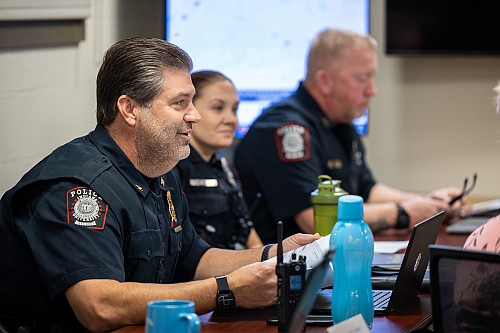Mock exercises prepare university for potential active aggressor situations
By Caroline Dwyer Gilley
November 16, 2022

More than 120 participants representing units across each campus have taken part so far, including IU Police Department, marketing and communications, residential life, student affairs, and campus administration.
“As we all have seen, active aggressor incidents have taken place across the country in recent years, and ensuring our campuses are prepared is critically important,” said Benjamin D. Hunter, associate vice president and superintendent for IU Public Safety.
Using the U.S. Department of Homeland Security’s Homeland Security Exercise and Evaluation Program, IU Emergency Management and Continuity staff designed a tabletop exercise for each campus that involved a plausible active aggressor incident. Tabletop exercises are discussion-based, as opposed to full-scale exercises where participants respond as they would in an actual emergency. These exercises are performed in a no-fault, casual environment, providing an opportunity for organizations to evaluate policies, plans and decision-making.
IU’s exercises involved Emergency Management and Continuity staff presenting a detailed potential scenario, followed by a series of questions and subsequent information about how the scenario unfolds over the course of a day. Participants worked through different elements of a response through communication and troubleshooting.
“Tabletop exercises are important because they allow campus partners — both public safety and campus leaders — a chance to walk through threat and hazard scenarios and develop strategies prior to these types of incidents occurring,” said Carlos Garcia, director of planning for Emergency Management and Continuity, who planned the exercises. “Additionally, they facilitate ongoing communication and coordination among essential campus stakeholders that occur beyond the tabletop exercise.”
Following each exercise, participants are asked to provide feedback, including their observations and ideas for improvements. In addition, each participant receives an executive summary detailing key actions and critical decisions made during the exercise.
“So far, the response on each campus has been positive,” Garcia said. “Several campus leaders have expressed interest in expanding the discussion of active aggressor threats to a broader audience on each campus.”
Once the exercises are completed on each of IU’s campuses, planning will begin for another series of exercises in 2023 that will cover additional threats and hazards that could potentially impact the IU community. Emergency Management and Continuity staff will work directly with each campus to plan for and conduct the next round of exercises to ensure IU is as prepared as possible for any potential emergency situation.
The university also recently updated its “Run, Hide, Fight” video to train individuals on how to react in a potential active aggressor situation.
Caroline Dwyer Gilley is public safety communications manager with the Office of the Vice President for Communications and Marketing.